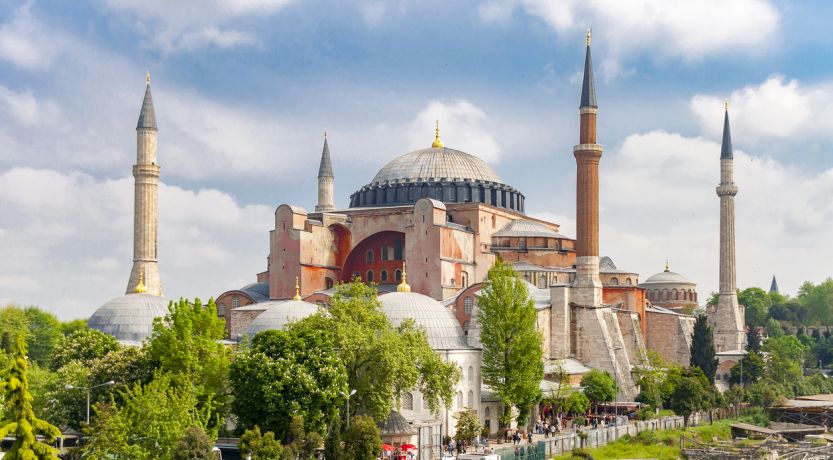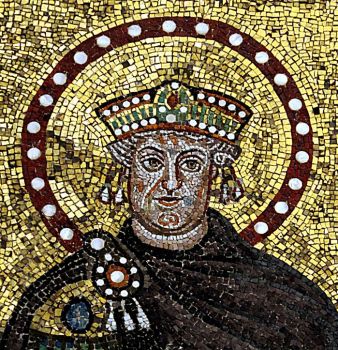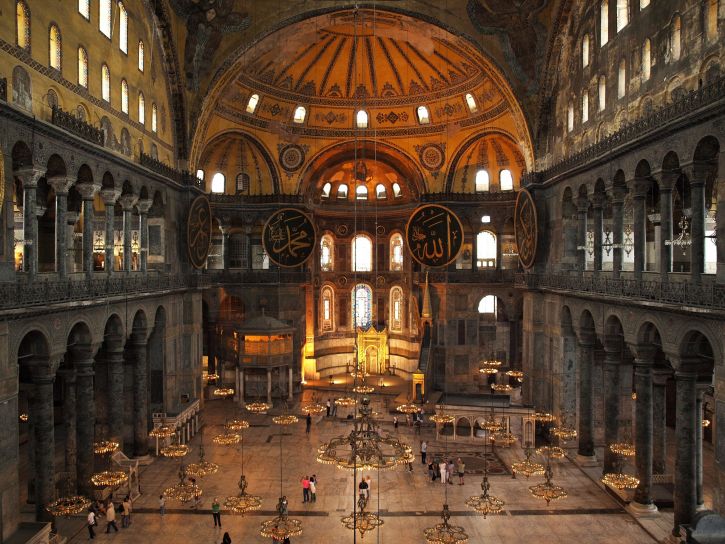What’s the Significance of Turkey’s Hagia Sophia Decision?
The Hagia Sophia was a church, became a mosque, then a museum, and is now being turned back into a mosque. What’s the significance of this latest change?

The Hagia Sophia was originally built by Emperor Justinian I (527-565), also known as Justinian the Great. Justinian was emperor of the Eastern Roman Empire, also known as the Byzantine Empire, in Constantinople (modern-day Istanbul, Turkey).
After a failed attempt to conquer the Persians, Justinian set his eyes on reviving the glory of the Roman Empire, which had fallen in the west to the Germanic tribes. Through a series of brutal and fierce wars, he expanded the empire to include the territories around the Mediterranean, once again turning the Mediterranean into a Roman lake.
He tried to unite the empire under the “most holy Catholic and Apostolic Church of God.” He defended the Catholic Church by establishing new laws against paganism and heretics.
Building the Hagia Sophia
One of Justinian’s greatest ecclesiastical achievements was rebuilding the church of the Hagia Sophia, which means “holy wisdom” in Greek.
Justinian I is credited with building the Hagia Sophia that stands today. 
Justinian began rebuilding the Hagia Sophia only a few weeks later, and it opened for religious services late in 537. It stood as the world’s largest cathedral for a thousand years, and it is a central site for the Greek Orthodox faith. It became a symbol of the triumph and power of Justinian and his version of Christianity.
Justinian’s Hagia Sophia was (and still is) an architectural and engineering marvel.
Rise and fall of the Ottoman Empire
In 1453 Constantinople fell to the Ottoman Islamic forces led by Emperor Fatih Sultan Mehmed II (known as “Mehmed the Conqueror”). This put an end to the 1,000-year reign of the Byzantine Empire.
The Ottomans converted the Hagia Sophia into a mosque and redecorated it with Islamic calligraphy.
The Ottoman Empire became one of the most powerful empires of its time. At its peak, the Ottoman sultan controlled the present-day regions of Turkey, Greece, Bulgaria, Egypt, Hungary, Macedonia, Romania, Jordan, Palestine, Lebanon, Syria, Arabia and parts of northern Africa.
The Ottomans launched a series of wars into Europe. They made it as far as the gates of Vienna, but were pushed back. This ended their attempts to expand into Europe.
At the start of World War I, the declining Ottoman Empire sided with Germany and the Austro-Hungarian Empire against the Allied powers, leading to their defeat in October 1918. The Ottoman territories were divided among the victors: Britain, France, Greece and Russia. This effectively ended the empire that had ruled over this area for over 400 years.
Ultimately, a portion of this territory became the republic of Turkey, and Mustafa Kemal Atatürk, who served as Turkey’s first post-Ottoman president, initiated a series of reforms to secularize and westernize Turkey. In 1923 the former empire became a republic. He amended the constitution of Turkey to remove Islam as the official state religion.
One of his reforms was to convert the Hagia Sophia from a mosque to a museum, making it one of the most visited tourist attractions in Turkey.
Inside the Hagia Sophia.
Islamization of Turkey
However, in recent years many of Atatürk’s reforms have been rolled back. Turkey’s President Recep Tayyip Erdoğan has led an effort of Islamization of Turkish society. His reforms have included:
- Building of Mosques: Erdoğan has funded mega-mosques both in Turkey and abroad (including the Balkans, Ghana, Kyrgyzstan and the United States) with plans to build in Venezuela and Cuba. Within Ankara, President Erdoğan has also funded many smaller mosques.
- Religious schooling: In an attempt to create a “pious generation,” President Erdoğan has introduced compulsory religious classes. In Islamic schools, up to a third of the curriculum is centered around an Islamic worldview.
- Headscarves: Turkey’s secular constitution banned wearing headscarves to keep religious clothing out of the civil life of the nation. President Erdoğan lifted the ban saying, “A dark time eventually comes to an end.”
- Reviving the dream of the Ottoman Empire: Turkey has undergone a remarkable economic and political transformation in just a decade. It has increased its influence and inserted itself into the affairs of nations in the region: Syria, Libya and Iraq. Many believe Turkey is trying to overtake Saudi Arabia as the leading nation in the Sunni Muslim world.
Responses to the transformation of the Hagia Sophia into a mosque
In recent weeks, President Erdoğan’s decision to transform the Hagia Sophia into a mosque and open it for worship has sent shock waves around the world, with many condemning the change. Consider the following responses:
- Pope Francis: “I think of Hagia Sophia, and I am very saddened.”
- Greek Orthodox Patriarch Bartholomew: “The potential conversion of Hagia Sophia into a mosque will turn millions of Christians around the world against Islam.”
- Greek Prime Minister Kyriakos Mitsotakis: “This is a choice which offends all those who also recognise the monument as a World Heritage Site. And of course it does not only affect relations between Turkey and Greece, but its relations with the European Union.”
- Russian Orthodox Church: “It is a real shame that the concerns of the Russian Orthodox Church and other Orthodox churches were not heard. This decision, alas, is not aimed at reconciling existing differences, but on the contrary, may lead to even greater divisions.”
- European Union: The EU Foreign Affairs Council reported that ministers of its member states “condemned the Turkish decision to convert Hagia Sophia back to a mosque as this decision will inevitably fuel mistrust, promote renewed divisions between religious communities and undermine efforts at dialogue and cooperation. There was broad support to call on the Turkish authorities to urgently reconsider and reverse their decision.”
- UNESCO: “It is regrettable that the Turkish decision was not the subject of dialogue nor notification beforehand. UNESCO calls on the Turkish authorities to open a dialogue without delay in order to avoid a step back from the universal value of this exceptional heritage whose preservation will be reviewed by the World Heritage Committee in its next session.”
Recent tensions between Europe and Muslims
Incidents like the conversion of the Hagia Sophia into a mosque contribute to further tensions between two of history’s great civilizations. Though Christianity is not as popular in Europe today as it was historically, Europe is still a civilization with a history and tradition rooted in Western Christianity.
Historically, Christian Europe has often come into conflict with the Islamic world. Consider some of the recent tensions between these two civilizations:
- Radical Islamic terror attacks. In the last decade, a number of European cities have been the targets of Islamic terror attacks:
- The 2015 Bataclan concert hall attack in Paris, France, that killed 90 people.
- The 2015 attack on the Charlie Hebdo offices (also in Paris) that killed 12 people.
- The 2016 attack on the Brussels airport and a metro station that killed 32 people.
- The 2017 Barcelona attacks where a van hit pedestrians, killing 16 people.
- Lack of Muslim integration into secular Europe. For the vast majority of Europeans, religion does not play a major role in everyday life. In contrast, for many Muslims, Islamic practices are heavily integrated into everyday life. For example, consider the wearing of hijab and face coverings, the Islamic call to prayer, praying in the streets, and imposition of Islamic blasphemy laws. The refusal of European Muslims to give up the outward practices of Islam to assimilate into secular Europe has caused anti-Islamic sentiment throughout Europe.
- Muslim immigration. Mass immigration of Muslims from the Middle East and Africa into Europe has been seen by many Europeans as a threat to the social fabric of European societies. This has caused a rise of nationalism and populism across Europe, fueling a rise of right-wing parties that cite Islamic immigration as a major concern.
Distrust and suspicion of Islam simmers under the surface in Europe. Turkey’s abrupt decision to convert the Hagia Sophia into a mosque is a reminder that a simple spark could cause this tension to explode.
A future clash between Europe and the Islamic world
The Bible prophesies about a future clash between Christian Europe (known as the king of the North) and an Islamic Middle Eastern power (known as the king of South). A united Europe will be provoked to invade the Middle East with an overwhelming military force (Daniel 11:40-43).
The clash between Europe and the Middle Eastern power will begin a chain of events that will lead to the near annihilation of life on earth.
This European power will also invade the state of Israel and will set up the “abomination of desolation” in Jerusalem—which will involve the ending of Jewish sacrifices in the city. This shows that Jewish sacrifices will be started again. Perhaps the Jews offering sacrifices at (or near) the Temple Mount will be the trigger that causes a group of Muslim nations to form a confederation. (Events that take place in Jerusalem often have huge ramifications in the Middle East and the world.)
The Great Tribulation will begin shortly after the European power sets up this “abomination of desolation” in Jerusalem (Matthew 24:21). This is the 3½-year period of worldwide suffering that precedes Christ’s return to earth (Revelation 12:14; Daniel 12:7).
Continue to watch the Muslim world and Europe. A push against Europe by an Islamic power is going to trigger events that lead to the return of Jesus Christ Himself. History shows that a seemingly small event can spark a reaction of unimaginable scope.
Turkey’s recent decision to transform the Hagia Sophia into a mosque doesn’t seem to be that trigger, but it is a reminder of the underlying tensions between these two civilizations and how one decision could cause those tensions to explode.
Date Posted: August 18, 2020



